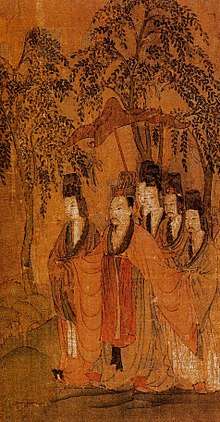Three Kingdoms
The Three Kingdoms (simplified Chinese: 三国时代; traditional Chinese: 三國時代; pinyin: Sānguó Shídài) from 220–280 CE was the tripartite division of China among the states of Wei, Shu, and Wu.[1] The Three Kingdoms period started with the end of the Han dynasty and was followed by the Jin dynasty. The short-lived Yan kingdom in Manchuria, which lasted from 237 to 238 CE, is sometimes considered as a "4th kingdom".[2]
| Three Kingdoms | |||||||||||||||||||||||||||||||
|---|---|---|---|---|---|---|---|---|---|---|---|---|---|---|---|---|---|---|---|---|---|---|---|---|---|---|---|---|---|---|---|
| Chinese name | |||||||||||||||||||||||||||||||
| Traditional Chinese | 三國 | ||||||||||||||||||||||||||||||
| Simplified Chinese | 三国 | ||||||||||||||||||||||||||||||
| Hanyu Pinyin | Sānguó | ||||||||||||||||||||||||||||||
| Literal meaning | "three states" | ||||||||||||||||||||||||||||||
| |||||||||||||||||||||||||||||||
| Vietnamese name | |||||||||||||||||||||||||||||||
| Vietnamese | Tam Quốc | ||||||||||||||||||||||||||||||
| Hán-Nôm | 三國 | ||||||||||||||||||||||||||||||
| Korean name | |||||||||||||||||||||||||||||||
| Hangul | 삼국 | ||||||||||||||||||||||||||||||
| Hanja | 三國 | ||||||||||||||||||||||||||||||
| |||||||||||||||||||||||||||||||
| Japanese name | |||||||||||||||||||||||||||||||
| Hiragana | さんごく | ||||||||||||||||||||||||||||||
| Kyūjitai | 三國 | ||||||||||||||||||||||||||||||
| Shinjitai | 三国 | ||||||||||||||||||||||||||||||
| |||||||||||||||||||||||||||||||
| Three Kingdoms period | |||||||||||||||||||||||||||||||
|---|---|---|---|---|---|---|---|---|---|---|---|---|---|---|---|---|---|---|---|---|---|---|---|---|---|---|---|---|---|---|---|
| Chinese name | |||||||||||||||||||||||||||||||
| Traditional Chinese | 三國時代 | ||||||||||||||||||||||||||||||
| Simplified Chinese | 三国时代 | ||||||||||||||||||||||||||||||
| |||||||||||||||||||||||||||||||
| Vietnamese name | |||||||||||||||||||||||||||||||
| Vietnamese | Tam Quốc thời đại | ||||||||||||||||||||||||||||||
| Hán-Nôm | 三國時代 | ||||||||||||||||||||||||||||||
| Korean name | |||||||||||||||||||||||||||||||
| Hangul | 삼국 시대 | ||||||||||||||||||||||||||||||
| Hanja | 三國時代 | ||||||||||||||||||||||||||||||
| Japanese name | |||||||||||||||||||||||||||||||
| Hiragana | さんごくじだい | ||||||||||||||||||||||||||||||
| Kyūjitai | 三國時代 | ||||||||||||||||||||||||||||||
| Shinjitai | 三国時代 | ||||||||||||||||||||||||||||||
| |||||||||||||||||||||||||||||||
 | ||||||||
|---|---|---|---|---|---|---|---|---|
| ANCIENT | ||||||||
| Neolithic c. 8500 – c. 2070 BCE | ||||||||
| Xia c. 2070 – c. 1600 BCE | ||||||||
| Shang c. 1600 – c. 1046 BCE | ||||||||
| Zhou c. 1046 – 256 BCE | ||||||||
| Western Zhou | ||||||||
| Eastern Zhou | ||||||||
| Spring and Autumn | ||||||||
| Warring States | ||||||||
| IMPERIAL | ||||||||
| Qin 221–207 BCE | ||||||||
| Han 202 BCE – 220 CE | ||||||||
| Western Han | ||||||||
| Xin | ||||||||
| Eastern Han | ||||||||
| Three Kingdoms 220–280 | ||||||||
| Wei, Shu and Wu | ||||||||
| Jin 266–420 | ||||||||
| Western Jin | ||||||||
| Eastern Jin | Sixteen Kingdoms | |||||||
| Northern and Southern dynasties 420–589 | ||||||||
| Sui 581–618 | ||||||||
| Tang 618–907 | ||||||||
| (Wu Zhou 690–705) | ||||||||
| Five Dynasties and Ten Kingdoms 907–979 |
Liao 916–1125 | |||||||
| Song 960–1279 | ||||||||
| Northern Song | Western Xia | |||||||
| Southern Song | Jin | Western Liao | ||||||
| Yuan 1271–1368 | ||||||||
| Ming 1368–1644 | ||||||||
| Qing 1636–1912 | ||||||||
| MODERN | ||||||||
| Republic of China on mainland 1912–1949 | ||||||||
| People's Republic of China 1949–present | ||||||||
| Republic of China on Taiwan 1949–present | ||||||||
To distinguish the three states from other historical Chinese states of the same names, historians have added a relevant character to the state's original name: the state that called itself Wei (魏) is also known as Cao Wei (曹魏),[3][4] the state that called itself Han (漢) is also known as Shu Han (蜀漢) or just Shu (蜀), and the state that called itself Wu (吳) is also known as Eastern Wu (東吳; Dōng Wú) or Sun Wu (孫吳).
Academically, the period of the Three Kingdoms refers to the period between the foundation of the state of Wei in 220 CE and the conquest of the state of Wu by the Jin dynasty in 280. The earlier, "unofficial" part of the period, from 184 to 220, was marked by chaotic infighting between warlords in various parts of China. The middle part of the period, from 220 to 263, was marked by a more militarily stable arrangement between three rival states of Wei, Shu, and Wu. The later part of the era was marked by the conquest of Shu by Wei (263), the usurpation of Wei by the Jin dynasty (265), and the conquest of Wu by the Jin (280).
The Three Kingdoms period is one of the bloodiest in Chinese history. A nationwide census taken in 280 CE, following the reunification of the Three Kingdoms under the Jin shows a total of 2,459,840 households and 16,163,863 individuals which was only a fraction of the 10,677,960 households, and 56,486,856 individuals reported during the Han era.[5] While the census may not have been particularly accurate due to a multitude of factors of the times, the Jin in 280 CE did make an attempt to account for all individuals where they could.[6]
Technology advanced significantly during this period. Shu chancellor Zhuge Liang invented the wooden ox,[7] suggested to be an early form of the wheelbarrow,[8] and improved on the repeating crossbow.[9] Wei mechanical engineer Ma Jun is considered by many to be the equal of his predecessor Zhang Heng.[10] He invented a hydraulic-powered, mechanical puppet theatre designed for Emperor Ming of Wei, square-pallet chain pumps for irrigation of gardens in Luoyang, and the ingenious design of the south-pointing chariot, a non-magnetic directional compass operated by differential gears.[11]
Although relatively short, this historical period has been greatly romanticized in the cultures of China, Japan, Korea, and Vietnam. It has been celebrated and popularized in operas, folk stories, novels and in more recent times, films, television, and video games. The best known of these is Luo Guanzhong's Romance of the Three Kingdoms, a Ming dynasty historical novel based on events in the Three Kingdoms period.[12] The authoritative historical record of the era is Chen Shou's Records of the Three Kingdoms, along with Pei Songzhi's later annotations of the text.
The English-language term "Three Kingdoms" is something of a misnomer, since each state was eventually headed not by a king, but by an emperor who claimed suzerainty over all China.[13] Nevertheless, the term "Three Kingdoms" has become standard among English-speaking sinologists.
Periodization
There is no set time period for the era. Strictly speaking, the Three Kingdoms, or independent states, only existed from 229 with the proclamation of the Eastern Wu ruler as emperor until the downfall of Shu Han in 263. Another interpretation of the period is that it began with the decline of the Han royal house. According to Mao Zonggang, a commentator on the Romance of the Three Kingdoms, in his commentary on Chapter 120 of the novel:
The three kingdoms formed when the Han royal house declined. The Han royal house declined when the eunuchs abused the sovereign and officials subverted the government.[14]
Mao Zonggang suggests that the historiography of the Three Kingdoms began with the rise of the Ten Eunuchs. He further argues that the Romance of the Three Kingdoms defines the end of the era as 280, the downfall of Wu, justifying:
As the novel focuses on Han, it could have ended with the fall of Han. But Wei usurped Han. To end the tale before Han's enemy had itself met its fate would be to leave the reader unsatisfied. The novel could have ended with the fall of Wei, but Han's ally was Wu. To end the tale before Han's ally had fallen would be to leave the reader with an incomplete picture. So the tale had to end with the fall of Wu.[14]
Several other starting points for the period are given by Chinese historians: during the final years of the Han dynasty, such as the Yellow Turban Rebellion in 184;[15][16] the year after the beginning of the rebellion, 185;[17] Dong Zhuo deposing Emperor Shao of Han and enthroning Emperor Xian of Han in 189;[18][19] Dong Zhuo sacking Luoyang and moving the capital to Chang'an in 190;[20] or Cao Cao placing the emperor under his control in Xuchang in 196.[21][22][23][24][25]
History
Yellow Turban Rebellion
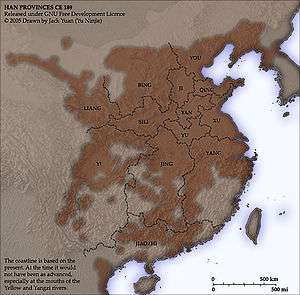
(In the late Han dynasty period, 189 CE).
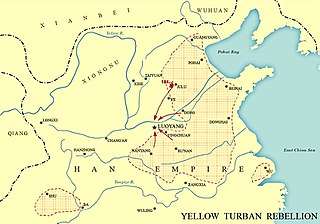
The power of the Eastern Han dynasty went into depression and steadily declined from a variety of political and economic problems after the death of Emperor He in 105 CE. A series of Han emperors ascended the throne while still youths, and "de facto" imperial power often rested with the emperors' older relatives. As these relatives occasionally were loath to give up their influence, emperors would, upon reaching maturity, be forced to rely on political alliances with senior officials and eunuchs to achieve control of the government. Political posturing and infighting between imperial relatives and eunuch officials was a constant problem in Chinese government at the time.[26] During the reigns of Emperor Huan (r. 146–168) and Emperor Ling (r. 168–189), leading officials' dissatisfaction with the eunuchs' usurpations of power reached a peak, and many began to openly protest against them. The first and second protests met with failure, and the court eunuchs persuaded the emperor to execute many of the protesting scholars. Some local rulers seized the opportunity to exert despotic control over their lands and citizens, since many feared to speak out in the oppressive political climate. Emperors Huan and Ling's reigns were recorded as particularly dark periods of Han dynasty rule. In addition to political oppression and mismanagement, China experienced a number of natural disasters during this period, and local rebellions sprung up throughout the country.
In the third month of 184, Zhang Jiao, leader of the Way of Supreme Peace, a Taoist movement, along with his two brothers Zhang Liang and Zhang Bao, led the movement's followers in a rebellion against the government that was called the Yellow Turban Rebellion. Their movement quickly attracted followers and soon numbered several hundred thousand and received support from many parts of China. They had 36 bases throughout China, with large bases having 10,000 or more followers and minor bases having 6,000 to 7,000, similar to Han armies. Their motto was:
"The firmament[lower-alpha 1] has perished, the Yellow Sky[lower-alpha 2] will soon rise; in this year of jiazi, let there be prosperity in the world!"
(蒼天已死,黃天當立。歲在甲子,天下大吉。)[lower-alpha 3]
Emperor Ling dispatched generals Huangfu Song, Lu Zhi, and Zhu Jun to lead the Han armies against the rebels, and decreed that local governments had to supply soldiers to assist in their efforts. It is at this point that the historical novel Romance of the Three Kingdoms begins its narrative. The Yellow Turbans were ultimately defeated and its surviving followers dispersed throughout China, but due to the turbulent situation throughout the empire, many were able to survive as bandits in mountainous areas, thus continuing their ability to contribute to the turmoil of the era.
With the widespread increase in bandits across the Chinese nation, the Han army had no way to repel each and every raiding party. In 188, Emperor Ling accepted a memorial from Liu Yan suggesting he grant direct administrative power over feudal provinces and direct command of regional military to local governors, as well as promoting them in rank and filling such positions with members of the Liu family or court officials. This move made provinces (zhou) official administrative units, and although they had power to combat rebellions, the later intragovernmental chaos allowed these local governors to easily rule independently of the central government. Liu Yan was also promoted as governor of Yi Province[lower-alpha 4]. Soon after this move, Liu Yan severed all of his region's ties to the Han imperial court, and several other areas followed suit.
Dong Zhuo in power
In the same year, Emperor Ling died, and another struggle began between the court eunuchs for control of the imperial family. Court eunuch Jian Shuo planned to kill Regent Marshal He Jin, a relative of the imperial family, and to replace the crown prince Liu Bian with his younger brother Liu Xie, the Prince of Chenliu (in present-day Kaifeng), though his plan was unsuccessful. Liu Bian took the Han throne as Emperor Shao, and He Jin plotted with warlord Yuan Shao to assassinate the Ten Attendants, a clique of twelve eunuchs led by Zhang Rang who controlled much of the imperial court. He Jin also ordered Dong Zhuo, the frontier general in Liang Province, and Ding Yuan, Inspector of Bing Province,[lower-alpha 5] to bring troops to the capital to reinforce his position of authority. The eunuchs learned of He Jin's plot, and had him assassinated before Dong Zhuo reached the capital Luoyang. When Yuan Shao's troops reached Luoyang, they stormed the palace complex, killing the Ten Attendants and 2,000 of the eunuchs' supporters. Though this move effectively ended the century-long feud between the eunuchs and the imperial family, this event prompted the invitation of Dong Zhuo to the outskirts of Luoyang from the northwest boundary of China.
On the evening of 24 September 189, General Dong Zhuo observed that Luoyang was set ablaze—as a result of a power struggle between the eunuchs and civil service—and commanded his army forward to strike down the disorder.[27] As the emperor had lost any remaining military or political power, Dong Zhuo seized the de facto control of the government located at Luoyang.[27] On 28 September, Dong Zhuo deposed Liu Bian from the imperial Han throne in favor of Liu Xie.[27] In the following weeks, rebellions broke out throughout all of China.[28]
In East China, in an attempt to restore the power of the Han, a large coalition against Dong Zhuo began to rise, with leaders such as Yuan Shao, Yuan Shu, and Cao Cao.[28] Many provincial officials were compelled to join or risk elimination.[29] In 191, Sun Jian (Yuan Shu's subordinate) led an army against Dong Zhuo and drove him from Luoyang to Chang'an.[30] In the following year (192), Lü Bu, Dong Zhuo's former bodyguard, assassinated Dong Zhuo.[29]
Collapse of central power
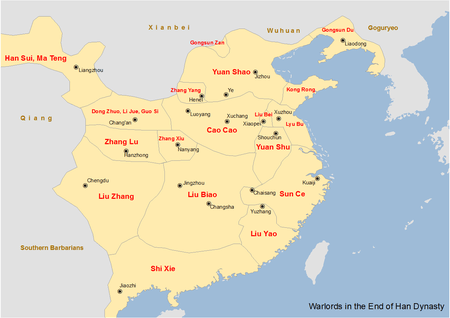
In 192, there was some talk among the coalition of appointing Liu Yu, an imperial relative, as emperor, and gradually its members began to fall out. Most of the warlords in the coalition, with a few exceptions, sought the increase of personal military power in the time of instability instead of seriously wishing to restore the Han dynasty's authority. The Han empire was divided between a number of regional warlords. As a result of the complete collapse of the central government and eastern alliance, the North China Plain fell into warfare and anarchy with many contenders vying for success or survival.[29] Emperor Xian fell into the hands of various warlords in Chang'an.
Dong Zhuo, confident in his success, was slain by his follower Lü Bu, who plotted with minister Wang Yun. Lü Bu, in turn, was attacked by Dong Zhuo's former officers: Li Jue, Guo Si, Zhang Ji and Fan Chou. Wang Yun and his whole family were executed. Lü Bu fled to Zhang Yang, a northern warlord, and remained with him for a time before briefly joining Yuan Shao, but it was clear that Lü Bu was far too independent to serve another.
Yuan Shao operated from Ye city in Ji Province, extending his power north of the Yellow River.[29] Han Fu had formerly been the Governor of Ji Province, but he came under the control of Yuan Shao and was replaced by him.[30]
Between the Yellow and Huai rivers, a conflict had erupted between Yuan Shu, Cao Cao, Tao Qian (Governor of Xu Province) and Lü Bu.[29] Cao Cao forced the Yellow Turbans to surrender in 192,[31] drove Yuan Shu to the south of the Huai River in 193,[29] inflicted devastation upon Tao Qian in 194,[30] received the surrender of Liu Bei (then a commander under Tao Qian) in 196,[32] and captured and executed Lü Bu in 198.[32] Cao was now in complete control of the southern part of the North China Plain.[32]
In the northeast, Gongsun Du held control of southern Manchuria, where he had established a state.[33] He was succeeded by his son Gongsun Kang in 204.[33] In the north across the frontier, since the fall of imperial control, the region had become chaotic as the Xiongnu remnants came into conflict with the Xianbei.[33]Goguryeo was invaded by warlord Gongsun Kang in 204, resulting in the Daifang Commandery. In 209, Kang invaded Goguryeo again, took the capital of Goguryeo and forced them to submit. Goguryeo was forced to move its capital further east.[34] In Liang Province (present-day Gansu), rebellion had erupted in 184.[33] In the west, Liu Yan had been Governor of Yi Province since his appointment in 188.[35] He was succeeded by his son Liu Zhang in 194.[35] Directly north of Liu Zhang's territory, Zhang Lu (leader of the Five Pecks of Rice) led a theocratic government at Hanzhong commandary (on the upper Han River).[36] Liu Biao held control over his province as the Governor of Jing Province.[36] Sun Quan held control over the lower Yangtze.[36]
Xu and Yan provinces
In 194, Cao Cao went to war with Tao Qian of Xu Province, because Tao's subordinate Zhang Kai had murdered Cao Cao's father Cao Song. Tao Qian received the support of Liu Bei and Gongsun Zan, but even then it seemed as if Cao Cao's superior forces would overrun Xu Province entirely. Cao Cao received word that Lü Bu had seized Yan Province in his absence, and accordingly he retreated, putting a halt to hostilities with Tao Qian for the time being. Tao Qian died in the same year, leaving his province to Liu Bei. A year later, in 195, Cao Cao managed to drive Lü Bu out of Yan Province. Lü Bu fled to Xu Province and was received by Liu Bei, and an uneasy alliance began between the two.
Afterwards, Lü Bu betrayed Liu Bei and seized Xu Province, forming an alliance with Yuan Shu's remnant forces. Liu Bei, together with his followers Guan Yu and Zhang Fei, fled to Cao Cao, who accepted him. Soon, preparations were made for an attack on Lü Bu, and the combined forces of Cao Cao and Liu Bei invaded Xu Province. Lü Bu's men deserted him, Yuan Shu's forces never arrived as reinforcements, and he was bound by his own subordinates Song Xian (宋憲) and Wei Xu (魏續) and executed on Cao Cao's order.
Huai River
Yuan Shu, after being driven south in 193, established himself at his new capital Shouchun (present-day Anhui).[32] He attempted to regain lost territory north of the Huai River.[32] In 197, Yuan Shu declared himself emperor of his own dynasty.[32] The move was a strategic blunder, as it drew the ire of many warlords across the land, including Yuan Shu's own subordinates who almost all abandoned him.[31] Abandoned by almost all his allies and followers, he perished in 199.[37]
Emperor Xian's fate
In August 195, Emperor Xian fled the tyranny of Li Jue at Chang'an and made a year long hazardous journey east in search of supporters. In 196, Emperor Xian came under the protection and control of Cao Cao after he had succeeded in fleeing from the warlords of Chang'an.[37] Establishing the imperial court at Xuchang in Henan, Cao Cao—who now held the de facto control—rigorously followed the formalities of the court and justified his actions as a loyal minister of the Han.[37] By then, most of the smaller contenders for power had either been absorbed by larger ones or destroyed. This was an extremely important move for Cao Cao following the suggestion from his primary adviser, Xun Yu, commenting that by supporting the authentic emperor, Cao Cao would have the formal legal authority to control the other warlords and force them to comply in order to restore the Han dynasty.
North China Plain
Cao Cao, whose zone of control was the precursor to the state of Cao Wei, had raised an army in 189. In several strategic movements and battles, he controlled Yan Province and defeated several factions of the Yellow Turban rebels. This earned him the aid of other local militaries controlled by Zhang Miao and Chen Gong, who joined his cause to create his first sizable army. He continued the effort and absorbed approximately 300,000 Yellow Turban rebels into his army as well as a number of clan-based military groups from the eastern side of Qing Province.
Since 192, He developed military agricultural colonies (tuntian) to support his army. Although the system imposed a heavy tax on hired civilian farmers (40% to 60% of agricultural production), the farmers were more than pleased to be able to work with relative stability and professional military protection in a time of chaos. This was later said to be his second important policy for success.
In 200, Dong Cheng, an imperial relative, received a secret edict from Emperor Xian to assassinate Cao Cao. He collaborated with Liu Bei on this effort, but Cao Cao soon found out about the plot and had Dong Cheng and his conspirators executed, with only Liu Bei surviving and fleeing to join Yuan Shao in the north.
After settling the nearby provinces, including a rebellion led by former Yellow Turbans, and internal affairs with the court, Cao Cao turned his attention north to Yuan Shao, who himself had eliminated his northern rival Gongsun Zan that same year. Yuan Shao, himself of higher nobility than Cao Cao, amassed a large army and camped along the northern bank of the Yellow River.
In the summer of 200, after months of preparations, the armies of Cao Cao and Yuan Shao clashed at the Battle of Guandu (near present-day Kaifeng).[37] Cao Cao's army was heavily outnumbered by Yuan Shao.[37] Due to a raid in Yuan's supply train, Yuan's army fell into disorder as they fled back north.[37]
Cao Cao took advantage of Yuan Shao's death in 202, which resulted in division among his sons, and advanced to the north.[37] In 204, after the Battle of Ye, Cao Cao captured the city of Ye.[37] By the end of 207, after a victorious campaign beyond the frontier against the Wuhuan culminating in the Battle of White Wolf Mountain, Cao Cao achieved complete dominance of the North China Plain.[38] He now controlled China's heartland, including Yuan Shao's former territory, and half of the Chinese population.[33]
South of the Yangtze
In 193, Huang Zu led the forces of Liu Biao in a campaign against Sun Jian (Yuan Shu's subordinate general) and killed him.[39] In 194, Sun Ce (aged 18) came into the military service under Yuan Shu.[36] He was given the command of some troops who formerly had been commanded by his late father Sun Jian.[36] In the south, he defeated the warlords of Yang Province, including Liu Yao, Wang Lang, and Yan Baihu. In 198, Sun Ce (aged 23) declared his independence from Yuan Shu who recently had declared himself emperor.[36] He held control over Danyang, Wu, and Kuaiji commandaries (from present-day Nanjing to the Hangzhou Bay and some outposts at the Fujian coast), while expanding westward in a series of campaigns.[36] By 200, he had conquered Yuzhang commandary (at present-day Lake Poyang in Jiangxi) and Lujiang (north of the Yangtze).[36] In 200, Sun Ce was ambushed and assassinated by the former retainers of a defeated rival from Wu.[40]
Sun Quan (aged 18) succeeded him and quickly established his authority.[40] By 203, he was expanding westward.[40] In 208, Sun Quan defeated Huang Zu (Liu Biao's subordinate commander) around present-day Wuhan.[40] He now held control over the territories south of the Yangtze (below Wuhan, Poyang region, and Hangzhou Bay).[40] His navy established local superiority over the Yangtze.[40] Nevertheless, he would soon come under the threat of Cao Cao's larger armies.[40]
Jing Province
During Dong Zhuo's reign over the Han government, Liu Biao had been appointed as the Governor of Jing Province.[40] His territory was located around his capital Xiangyang and the territory to the south around the Han and Yangtze River.[40] Beyond his eastern border was the territory of Sun Quan.[40]
In 200, during the time of the campaign around Guandu between Cao Cao and Yuan Shao, Liu Bei's forces had been defeated by a detachment of Cao Cao's army, forcing Liu Bei to flee and seek refuge with Liu Biao in Jing Province.[41] In this exile, Liu Bei maintained his followers who had accompanied him and made new connections within Liu Biao's entourage.[41] It was during this time that Liu Bei also met Zhuge Liang.[41]
In the autumn of 208, Liu Biao died and was succeeded by his youngest son Liu Cong over the eldest son Liu Qi through political maneuvering.[40] Liu Bei had become the head of the opposition to a surrender when Cao Cao's army marched southward to Jing.[41] After the advice of his supporters, Liu Cong surrendered to Cao Cao.[40] Cao Cao took control of the province and began appointing scholars and officials from Liu Biao's court to the local government.[40] Meanwhile, Liu Qi had joined Liu Bei to establish a line of defense at the Yangtze River against the surrender to Cao Cao, but they suffered defeat at the hands of Cao Cao.[42] In the aftermath, they retreated and sought support from Sun Quan.[40] Guan Yu (Liu Bei's subordinate lieutenant) had managed to retrieve most of Jing Province's fleet from the Han River.[40] Cao Cao occupied the naval base at Jiangling on the Yangtze River.[40] He would now begin proceeding eastwards towards Sun Quan with his armies and new fleet, while sending messengers to demand Sun Quan's surrender.[43]
Battle of Red Cliffs
In 208, Cao Cao marched south with his army hoping to quickly unify the empire. Liu Biao's son Liu Cong surrendered Jing Province and Cao was able to capture a sizable fleet at Jiangling. Sun Quan, the successor to Sun Ce in the lower Yangtze, continued to resist. His advisor Lu Su secured an alliance with Liu Bei, himself a recent refugee from the north, and Zhou Yu was placed in command of Sun Quan's navy, along with a veteran general who served the Sun family, Cheng Pu. Their combined armies of 50,000 met Cao Cao's fleet and 200,000-strong force at Red Cliffs that winter. After an initial skirmish, an attack beginning with a plan to set fire to Cao Cao's fleet was set in motion to lead to the decisive defeat of Cao Cao, forcing him to retreat in disarray back to the north. The allied victory at Red Cliffs ensured the survival of Liu Bei and Sun Quan, and provided the basis for the states of Shu and Wu.
Final years of the dynasty
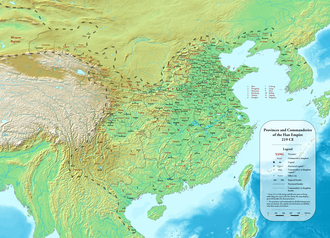
In 209, Zhou Yu captured Jiangling, establishing the south's complete dominance over the Yangtze River.[43] Meanwhile, Liu Bei and his principal adviser Zhuge Liang captured the Xiang River basin commandaries, establishing control over the southern territories of Jing province.[44] Sun Quan was forced to cede the territory around Jiangling to Liu Bei, because he could not establish a proper authority over it after Zhou Yu's death in 210.[44]
In 211, Cao Cao defeated a warlord coalition in the Wei valley, ending in the Battle of Huayin, capturing the territory around Chang'an.[44] In 211, Liu Bei accepted an invitation from Liu Zhang to come to Yi Province for aiding the latter against a threat from the north, namely Zhang Lu of Hanzhong.[45] Liu Bei met people within Liu Zhang's court who wished that he would replace Liu Zhang as the ruler of Yi Province.[45] A year after his arrival, Liu Bei came into conflict with Liu Zhang and turned against him.[45] In summer of 214, Liu Bei received the surrender of Liu Zhang, capturing Yi Province, and established his regime at Chengdu.[45] In 215, Cao Cao captured Hanzhong after attacking and receiving the surrender of Zhang Lu.[46] He had launched the attack from Chang'an through the Qinling Mountain passes to Hanzhong.[46] The conquest threatened Liu Bei's territory located directly to the south.[46] Cao Cao progressively increased his titles and power under the puppet Emperor Xian. He became the Chancellor in 208, the Duke of Wei in 214, and the King of Wei in 217.[47] He also compelled Sun Quan to accept suzerainty to Wei, but it had no real effect in practice.[47]
After Liu Bei had captured Yi Province from Liu Zhang in 214, Sun Quan—who had been engaged with Cao Cao in the southeast at the region between the Huai and Yangtze rivers during the intervening years—turned his attention to the middle Yangtze.[44] Cao Cao and Sun Quan had gained no success in breaking each other's positions.[44] Liu Fu, an administrator under Cao Cao, had established agricultural garrisons at Hefei and Shouchun to defend Cao's territory near the Huai river.[44] Sun Quan resented the fact that Liu Bei, a weaker ally, had gained so much territory west of him and demanded a larger share of the Xiang River basin.[44] In 215, Lü Meng (Sun Quan's officer) was sent to capture Jing province's southern commanderies, but Guan Yu (Liu Bei's general) launched a counterattack.[44] Later that year, Liu Bei and Sun Quan reached a settlement that the Xiang River would serve as the border between their territories.[44]
In the south, Sun Quan had sent He Qin, Lu Xun, and others to expand and conquer territory in what are now southern Zhejiang and Fujian provinces.[44]
In 219, Liu Bei seized Hanzhong by defeating and killing General Xiahou Yuan, who served Cao Cao.[47] Cao Cao sent reinforcements in an unsuccessful attempt to reclaim the territory.[47] Liu Bei had now secured his territory against the north and declared himself the King of Hanzhong.[47] In the east, Sun Quan attempted to capture Hefei from Cao Cao, but he did not succeed.[47]
While Lu Su had been chief commander for Sun Quan in Jing Province, their policy was to maintain the alliance with Liu Bei while Cao Cao was still a threat.[48] This changed when Sun Quan appointed Lü Meng when Lu Su died in 217.[48] In 219, Guan Yu sailed from Jiangling up the Han River towards the city of Fan (near Xianyang), but was unable to capture it.[49] In the autumn of 219, Lü Meng launched a surprise attack by sailing up the Yangtze towards Jiangling, resulting in its capture.[48] Guan Yu was unable to hold his position as most of his army surrendered.[48] He was captured and executed on Sun Quan's order. Cao Cao regained the Han valley, while Sun Quan captured all the territory east of the Yangtze Gorges.[48]
Emergence of the three kingdoms
At the beginning of 220, Cao Cao died and was succeeded by his son Cao Pi.[48] On 11 December, Emperor Xian abdicated and Cao Pi ascended the imperial throne by proclaiming the heavenly mandate as the Emperor of Wei.[48] On 15 May 221, Liu Bei responded by proclaiming himself as the Emperor of Han.[48] His state would become generally known as Shu Han.[48] Sun Quan continued to recognize his de jure suzerainty to Wei and was enfeoffed as the King of Wu.[48]
At the end of 221, Shu invaded Wu in response for Guan Yu's killing and the loss of Jing Province by Wu.[48] In the spring of 222, Liu Bei arrived at the scene to personally take command of the invasion.[48] Sun Quan dispatched Lu Xun to command over the defense of Wu against the invasion by Shu.[48] Against the advice of his subordinates, Lu Xun waited until Liu Bei was committed along the Yangtze below the Yangtze Gorges.[48] Finally, in the sixth month of 222, Lu Xun launched a series of fire attacks against the flank of Liu Bei's extended position which caused disorder in the Shu army and Liu Bei's retreat to Baidi (near present-day Fengjie).[50] Afterwards in 222, Sun Quan renounced his suzerainty to Wei and declared the independence of Wu.[51] In 223, Liu Bei perished at Baidi.[52] Zhuge Liang now acted as a regent for Liu Shan (aged 17) and held control of the Shu government.[53] Shu and Wu resumed their diplomatic relations by re-establishing peace and alliance in the winter of 223.[54] On 23 June 229, Sun Quan proclaimed himself as the Emperor of Wu.[55]
Shu controlled the upper Han valley and the territory west of the Yangtze Gorges.[56] The Qinling Mountains divided Shu and Wei.[56] Wei held control over the Wei and Huai valley, where agricultural garrisons were established at Shouchun and Hefei to defend Huai.[56] Military sorties by Wu against Hefei and Shouchun would consistently end in failure, thereby confirming Wei's hold over Huai.[56] Wu controlled all of the Yangtze valley.[56] The territory between the Huai and Yangtze was a desolate area, where a largely-static frontier between Wei and Wu had formed at the lower Han valley.[56]
The three states
Shu
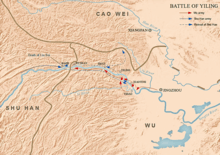
In 223, Liu Shan rose to the throne of Shu following his father's defeat and death. From 224 to 225, during his southward campaigns, Zhuge Liang conquered the southern territories up to Lake Dian in Yunnan.[53]
In 227, Zhuge Liang transferred his main Shu armies to Hanzhong, and opened up the battle for the northwest with Wei. The next year, he ordered Zhao Yun to attack from Ji Gorge as a diversion while Zhuge himself led the main force to Mount Qi. The vanguard Ma Su suffered a tactical defeat at Jieting and the Shu army was forced to withdraw. In the next six years Zhuge Liang attempted several more offensives, but supply problems limited the capacity for success. In 234, he led his last great northern offensive, reaching the Battle of Wuzhang Plains south of the Wei River. Due to the death of Zhuge Liang in 234, the Shu army was forced once again to withdraw, but were pursued by Wei. The Shu forces began to withdraw; Sima Yi deduced Zhuge Liang's demise and ordered an attack. Shu struck back almost immediately, causing Sima Yi to second guess and allow Shu to withdraw successfully.
Wu

Sun Quan turned to the aborigines of the southeast, whom the Chinese collectively called the "Shanyue". A collection of successes against the rebellious tribesmen culminated in the victory of 224. In that year, Zhuge Ke ended a three-year siege of Danyang with the surrender of 100,000 Shanyue. Of these, 40,000 were drafted as auxiliaries into the Wu army. Meanwhile, Shu was also experiencing troubles with the indigenous tribes of their south. The southwestern Nanman peoples rose in revolt against Shu authority, captured and looted cities in Yi Province. Zhuge Liang, recognizing the importance of stability in the south, ordered the advance of the Shu armies in three columns against the Nanman. He fought a number of engagements against the chieftain Meng Huo, at the end of which Meng Huo submitted. A tribesman was allowed to reside at the Shu capital Chengdu as an official and the Nanman formed their own battalions within the Shu army.
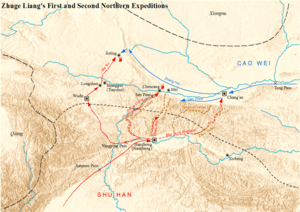
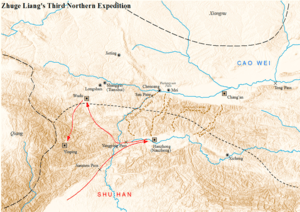
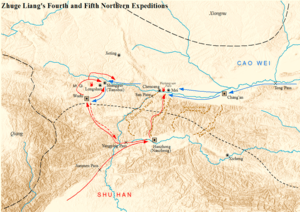
In the times of Zhuge Liang's northern offensives, the state of Wu had always been on the defensive against invasions from the north. The area around Hefei was the scene of many bitter battles and under constant pressure from Wei after the Battle of Red Cliffs. Warfare had grown so intense that many of the residents chose to migrate and resettle south of the Yangtze River. After Zhuge Liang's death, attacks on the southern Huai River region intensified but nonetheless, Wei could not break through the line of the river defenses erected by Wu, which included the Ruxu fortress.
Sun Quan's long reign is regarded as a time of plenty for his southern state. Migrations from the north and the settlement of the Shanyue increased manpower for agriculture, especially along the lower reaches of the Yangtze and in Kuaiji Commandery along the southern shore of Hangzhou Bay. River transport blossomed, with the construction of the Zhedong and Jiangnan canals. Trade with Shu flourished, with a huge influx of Shu cotton and the development of celadon and metal industries. Sea journeys were made to Manchuria and the island of Taiwan. In the south, Wu merchants reached Linyi (Southern Vietnam) and Funan Kingdom. As the economy prospered, so too did the arts and culture. In the Yangtze delta, the first Buddhist influences reached the south from Luoyang.
The Eastern Wu era was a formative period in Vietnamese history. A Jiaozhou (modern Vietnam and Guangzhou) prefect, Shi Xie, ruled Vietnam as an autonomous warlord for forty years and was posthumously deified by later Vietnamese emperors.[57] Shi Xie pledged loyalty to Eastern Wu. Originally satisfied with Eastern Wu's rule, the Vietnamese opposed Shi Hui's rebellion against Eastern Wu and attacked him for it. However, when the Wu general Lü Dai betrayed Shi Hui and executed the entire Shi family, the Vietnamese became greatly upset. In 248, the people of Jiaozhi and Jiuzhen commanderies rebelled. Eastern Wu sent Lu Yin to deal with the rebels. He managed to pacify the rebels with a combination of threats and persuasion. However the rebels regrouped under the leadership of Lady Triệu in Jiuzhen and renewed the rebellion with a march on Jiaozhi. According to the Đại Việt sử ký toàn thư (Complete Annals of Đại Việt), Lady Triệu had long breasts that reached her shoulders and rode into battle on an elephant. After several months of warfare she was defeated and committed suicide.[58]
Wei
In 226, Cao Pi died (aged 40) and was succeeded by his eldest son Cao Rui (aged 22).[59] Minister Chen Qun, General Cao Zhen, General Cao Xiu, and General Sima Yi[lower-alpha 6] were appointed as regents, even though Cao Rui was able to manage the government in practice.[59] Eventually the former three died, leaving only Sima Yi as the senior minister and military commander.[59] In 226, Sima Yi successfully defended Xiangyang against an offensive from Wu; this battle was the first time he had command in the field.[60] In 227, Sima Yi was appointed to a post at Chang'an where he managed the military affairs along the Han River.[60]
In 238, Sima Yi was dispatched to command a military campaign against Gongsun Yuan of the self-proclaimed Yan Kingdom in Manchuria, resulting in Sima Yi's capture of his capital Xiangping and massacre of his government.[60] Between 244 and 245, General Guanqiu Jian was dispatched to invade Goguryeo and severely devastated that state.[60] The northeastern frontier of Wei was now secured from any possible threats.[60] The invasions, a retaliation against a Goguryeo raid in 242, destroyed the Goguryeo capital of Hwando, sent its king fleeing, and broke the tributary relationships between Goguryeo and the other tribes of Korea that formed much of Goguryeo's economy. Although the king evaded capture and eventually settled in a new capital, Goguryeo was reduced to such insignificance that for half a century there was no mention of the state in Chinese historical texts.[61]
In 238, Cao Rui perished at age 35.[60] He was succeeded by his adopted son Cao Fang (aged 7), who was a close member of the imperial family.[60] Cao Rui had appointed Cao Shuang and Sima Yi to be Cao Fang's regents, even though he had contemplated to establish a regency council dominated by imperial family members.[60] Cao Shuang held the principal control over the court.[60] Meanwhile, Sima Yi was received the honorific title of Grand Tutor, but had virtually no influence at the court.[60]
Decline and end
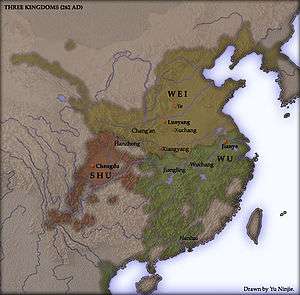
Fall of Shu
After Zhuge Liang's death, his position as chancellor fell to Jiang Wan, Fei Yi and Dong Yun, in that order. But after 258, Shu politics became increasingly controlled by the eunuch faction, led by Huang Hao, and corruption rose. Despite the energetic efforts of Jiang Wei, Zhuge Liang's protege, Shu was unable to secure any decisive achievement. In 263, Wei launched a three-pronged attack and the Shu army was forced into general retreat from Hanzhong. Jiang Wei hurriedly held a position at Jiange but he was outflanked by the Wei commander Deng Ai, who force-marched his army from Yinping through territory formerly considered impassable. By the winter of the year, the capital Chengdu fell due to the strategic invasion of Wei by Deng Ai who invaded Chengdu personally. The emperor Liu Shan thus surrendered. The state of Shu had come to an end after 43 years. Liu Shan was reinstated to the Wei capital of Luoyang and was given the new title of the "Duke of Anle". Directly translated, it meant the "Duke of Safety and Happiness" and was a trivial position with no actual power.
Fall of Wei
From the late 230s, tensions began to become visible between the imperial Cao clan and the Sima clan. Following the death of Cao Zhen, factionalism was evident between Cao Shuang and the Grand Tutor Sima Yi. In deliberations, Cao Shuang placed his own supporters in important posts and excluded Sima Yi, whom he regarded as a dangerous threat. The power of the Sima clan, one of the great landowning families of the Han dynasty, was bolstered by Sima Yi's military victories. Additionally, Sima Yi was an extremely capable strategist and politician. In 238 he crushed the rebellion of Gongsun Yuan's self-proclaimed Yan Kingdom and brought the Liaodong region directly under central control. Ultimately, he outmanoeuvred Cao Shuang in power play. Taking advantage of an excursion by the imperial clansmen to the Gaoping Tombs, Sima Yi undertook a putsch in Luoyang, forcing Cao Shuang's faction from authority. Many protested against the overwhelming power of the Sima family; notable among these were the Seven Sages of the Bamboo Grove (Chinese: 竹林七賢; lit.: 'Seven Virtues of the Bamboo Forest'). One of the sages, Xi Kang, was executed as part of the purges after Cao Shuang's downfall.
Cao Huan succeeded to the throne in 260 after Cao Mao was killed in a failed coup against Sima Zhao. Soon after, Sima Zhao died and his title as Duke of Jìn was inherited by his son Sima Yan. Sima Yan immediately began plotting to become emperor but faced stiff opposition. Following advice from his advisors, Cao Huan decided the best course of action would be to abdicate, unlike his predecessor Cao Mao. Sima Yan seized the throne in 266 after forcing Cao Huan's abdication, effectively overthrowing the Wei dynasty and establishing the successor Jin dynasty. This situation was similar to the deposal of Emperor Xian of Han by Cao Pi 40 years earlier.
Fall of Wu
Following Sun Quan's death and the ascension of the young Sun Liang to the throne in 252, the state of Wu went into steady decline. Successful Wei suppression of rebellions in the southern Huai River region by Sima Zhao and Sima Shi reduced any opportunity of Wu influence. The fall of Shu signalled a change in Wei politics. After Liu Shan surrendered to Wei, Sima Yan (grandson of Sima Yi), overthrew the Wei emperor and proclaimed his own dynasty of Jin in 266, ending 46 years of Cao dominion in the north. After Jin's rise, emperor Sun Xiu of Wu died, and his ministers gave the throne to Sun Hao. Sun Hao was a promising young man, but upon ascension he became a tyrant, killing or exiling all who dared oppose him in the court. In 269 Yang Hu, a Jin commander in the south, started preparing for the invasion of Wu by ordering the construction of a fleet and the training of marines in Sichuan under Wang Jun. Four years later, Lu Kang, the last great general of Wu, died leaving no competent successor. The planned Jin offensive finally came at the end of 279. Sima Yan launched five simultaneous offensives along the Yangtze River from Jianye (present-day Nanjing) to Jiangling while the Sichuan fleet sailed downriver to Jing Province. Under the strain of such an enormous attack, the Wu forces collapsed and Jianye fell in the third month of 280. Sun Hao surrendered and was given a fiefdom on which to live out his days. This marked the end of the Three Kingdoms era, and the beginning of a break in the forthcoming 300 years of disunity.
Impact
Population
After the Yellow Turban Rebellion, serious famine followed in the Central Plains of China. After his coming to power, Dong Zhuo gave full swing to his army to loot and plunder the population, and abduct women into forced marriages, servants or consorts. When the Guandong Coalition was starting the campaign against Dong Zhuo, he embarked upon a scorched earth campaign, proclaiming that "all the population of Luoyang be forced to move to Chang'an, all the palaces, temples, official residences and homes be burnt, no one should stay within that area of 200 li". Considering the hardships of that time this amounted to a death sentence for many, and cries of discontent rose as the population of Luoyang decreased sharply. When Cao Cao attacked Xu Province, it was said that "hundreds of thousands of men and women were buried alive, even dogs and chickens did not survive. The Si River was blocked. From then on, these five towns never recovered." When Li Jue and his army were advancing towards the Guanzhong area, "there remained hundreds of thousands of people, but Li Jue allowed his army to plunder the cities and the people, thus making the people have nothing but eat each other to death."
The following table shows the severe decrease of population during that period. From the late Eastern Han to the Western Jin dynasty, despite the length of about 125 years, the peak population only equaled 35.3% of the peak population during the Eastern Han dynasty. From the Western Jin dynasty to the Sui dynasty, the population never recovered. High militarization of the population was common. For example, the population of Shu was 900,000, but the military numbered over 100,000. The Records of the Three Kingdoms contains population figures for the Three Kingdoms. As with many Chinese historical population figures, these numbers are likely to be less than the actual populations, since census and tax records went hand in hand, and tax evaders were often not on records.
| Year | Households | Population | Notes |
|---|---|---|---|
| Eastern Han dynasty, 156 | 10,679,600 | 56,486,856 | |
| Shu Han, 221 | 200,000 | 900,000 | |
| Shu Han, 263 | 280,000 | 1,082,000 | At Shu's demise, the population contained 102,000 armed soldiers and 40,000 various officials. |
| Eastern Wu, 238 | 520,000 | 2,567,000 | |
| Eastern Wu, 280 | 530,000 | 2,535,000 | At Wu's demise, the population had 32,000 officials, 230,000 soldiers, and 5,000 imperial concubines. |
| Cao Wei, 260 | 663,423 | 4,432,881 | |
| Western Jin dynasty, 280 | 2,495,804 | 16,163,863 | After reuniting China, the Jin dynasty's population was greatest around this time. |
While it is clear that warfare undoubtedly took many lives during this period, the census figures do not support the idea that tens of millions were wiped out solely from warfare. Other factors such as mass famines and diseases, due to the collapse of sustaining governance and migrations out of China must be taken into account.
Economy
In the late Eastern Han dynasty, due to natural disasters and social unrest, the economy was badly depressed, leading to the massive waste of farmland. Some local landlords and aristocracy established their own strongholds to defend themselves and developed agriculture, which gradually evolved into a self-sufficient manorial system. The system of strongholds and manors also had effects on the economical mode of following dynasties. In addition, because of the collapse of the imperial court, those worn copper coins were not melted and reminted and many privately minted coins appeared. In the Three Kingdoms period, newly minted coins never made their way into currency. Due to the collapse of the coinage, Cao Wei officially declared silk cloth and grains as the main currencies in 221.[63]
In economic terms the division of the Three Kingdoms reflected a reality that long endured. Even during the Northern Song dynasty, 700 years after the Three Kingdoms period, it was possible to think of China as being composed of three great regional markets. (The status of the northwest was slightly ambivalent, as it had links with the northern region and Sichuan). These geographical divisions are underscored by the fact that the main communication routes between the three main regions were all man-made: the Grand Canal linking north and south, the hauling-way through the Three Gorges of the Yangtze River linking southern China with Sichuan and the gallery roads joining Sichuan with the northwest. The break into three separate entities was quite natural and even anticipated by such political foresight as that of Zhuge Liang (see Longzhong Plan).
Literature
Cao Cao, the founder of the Wei kingdom and his four sons were influential poets, especially Cao Zhi (192-232) and Cao Pi (187-226).[64] Cao Pi wrote the earliest work of literary criticism, the Essay on Literature. Cao Zhi, together with Xu Gan, sponsored a resurgence of the Jian'an style of lyric poetry. Cao Zhi is considered by most modern critics to be the most important Chinese writer between Qu Yuan and Tao Yuanming. [65]
Chen Shou's Records of the Three Kingdoms, as annotated by Pei Songzhi is the official history of the three states. The literary scholar Victor Mair remarks that "among its biographies is to be found some of the most interesting writing in the dynastic histories." [66]
Legacy in popular culture
Numerous people and affairs from the period later became Chinese legends. The most complete and influential example is the historical novel Romance of the Three Kingdoms, written by Luo Guanzhong during the Ming dynasty. Possibly due to the popularity of Romance of the Three Kingdoms, the Three Kingdoms era is one of the most well-known non-modern Chinese eras in terms of iconic characters, deeds and exploits. This is reflected in the way that fictional accounts of the Three Kingdoms, mostly based on the novel, play a significant role in East Asian popular culture. Books, television dramas, films, cartoons, anime, games, and music on the topic are still regularly produced in mainland China, Hong Kong, Taiwan, South Korea, Vietnam, Japan, and Southeast Asia.[67]
See also
- Battle of Hulao Pass
- End of the Han dynasty
- Game of the Three Kingdoms
- Jian'an poetry
- List of tributaries of Imperial China
- Period of Disunity
- Lists of people of the Three Kingdoms
- Rafe de Crespigny
- Records of the Three Kingdoms
- Romance of the Three Kingdoms
- Six Dynasties
- Six Dynasties poetry
Notes
- Referring to the Han dynasty government
- Referring to the Yellow Turban Rebellion
- Book of Han – Record of Emperor Xiaoling and the Zizhi Tongjian -Guanghe Year 6 record that Zhang Jiao declared himself Yellow Emperor and took their movement's name from a headscarf worn by followers [yellow signifying the Yellow Emperor and imperial authority].
- Roughly covering the Sichuan Basin
- The area between present-day Baoding and Taiyuan
- Earlier, in 217, Sima Yi had become a member of the heir apparent Cao Pi's entourage. He steadily rose in position during Cao Pi's reign. (Crespigny 1991,31)
References
- Theobald (2000).
- Kang, Youwei (21 October 2013). 歐洲十一國遊記二種 (in Chinese). 群出版. p. 98.
- Ward (2008), p. 15.
- San (2014), p. 145.
- Nicola Di Cosmo and Robin D. S. Yates. Military Culture in Imperial China. Harvard University Press. ISBN 978-0674031098.
- Hans Bielenstein. Chinese historical demography A.D. 2-1982. Östasiatiska museet. p 17
- Tseng, Jane (20 January 2015). "This Man Is Riding a Masterpiece Like Zhuge Liang's on the Street!". The Vision Times. Retrieved 31 March 2015.
the wooden ox (literally wooden ox and flowing horse) was first created by chancellor Zhuge Liang during the Three Kingdoms period.
- Breverton, Terry (2013). Breverton's Encyclopedia of Inventions (Unabridged ed.). Quercus. ISBN 978-1623652340.
- Szczepanski, Kallie. "The Invention of the Crossbow". About.com. Retrieved 31 March 2015.
Repeating crossbows, called zhuge nu in Chinese, could shoot multiple bolts before needing to be reloaded. Traditional sources attributed this invention to a Three Kingdoms period tactician named Zhuge Liang (181–234 CE), but the discovery of the Qinjiazui repeating crossbow from 500 years before Zhuge's lifetime proves that he was not the original inventor. It seems likely that he improved significantly on the design. Later crossbows could fire as many as 10 bolts in 15 seconds before being reloaded.
- Hong-Sen Yan (2007). Reconstruction Designs of Lost Ancient Chinese Machinery (Online-Ausg. ed.). Dordrecht: Springer Science & Business Media. p. 129. ISBN 978-1402064609.
- Xiong, Victor Cunrui (2009). Historical Dictionary of Medieval China. Lanham, Md.: Scarecrow Press. p. 351. ISBN 978-0810860537.
- "Romance of the Three Kingdoms: China's Greatest Epic 三國志演義". Yellow Bridge. Retrieved 1 April 2015.
- Tanner, Harold Miles (13 March 2009). China: A History. Indianapolis, Indiana: Hackett Publishing. pp. 141–142. ISBN 978-0872209152.
- Roberts, Moss (1991). Three Kingdoms: A Historical Novel. California: University of California Press. ISBN 0-520-22503-1.
- Guo Jian (郭建) (1999). 千秋興亡 [Rise and Fall over Thousands of Autumns]. Changchun: 長春出版社 (Changchun Press).
- Jiang Lang (姜狼) (2011). 184–280:三國原來這樣 [184–280: It Turns out the Three Kingdoms Were like This]. Beijing: 現代出版社 (Modern Press).
- Han Guopan (韓國磐) (1983). 魏晉南北朝史綱 [Historical Highlights of the Six Dynasties]. Beijing: 人民出版社 (People's Press).
- Zhang Binsheng (張儐生) (1982). 魏晉南北朝政治史 [Administrative History of the Six Dynasties]. Taipei: 中國文化大學 (Chinese Culture University Press).
- Gao Min (高敏), ed. (1998). 中國經濟通史 魏晉南北朝經濟卷 [The Complete Economic History of China: Economy of the Six Dynasties]. Hong Kong: 經濟日報出版社 (Economics Daily Press).
- Luo Kun (羅琨); et al. (1998). 中國軍事通史 三國軍事史 [The Complete Military History of China: Three Kingdoms Military History]. Beijing: 軍事科學出版社 (Military Science Press).
- Zhu Dawei (朱大渭); et al. (1998). 魏晉南北朝社會生活史 [The Social History of the Six Dynasties]. Beijing: 中國社會科學出版社 (Chinese Academy of Social Sciences).
- Zhang Wenqiang (張文強) (1994). 中國魏晉南北朝軍事史 [China's Six Dynasties Military History]. Beijing: 人民出版社 (People's Press).
- Zhang Chengzong (張承宗); Wei Xiangdong (魏向東) (2001). 中國風俗通史 魏晉南北朝卷 [The Complete History of Chinese Customs: Six Dynasties]. Shanghai: 上海藝文出版社 (Shanghai People's Press).
- He Dezhang (何德章) (1994). 中國魏晉南北朝政治史 (百卷本國全史第7) [China's Six Dynasties Administrative History (This Nation's Total History in 100 Volumes, no 7)]. Beijing: 人民出版社 (People's Press).
- Wang Lihua (王利華); et al. (2009). 中國農業通史 魏晉南北朝卷 [The Complete History of Chinese Agriculture: Six Dynasties]. Beijing: 中國農業出版社 (Chinese Agricultural Press).
- Theobald, Ulrich (28 June 2011). "The Yellow Turban Uprising". Chinaknowledge. Retrieved 7 March 2015.
The reasons for the uprising are to be sought in the aggravating economic situation for many peasants. Endebted to rich landowners, peasants could often only survive when selling their land and becoming tenant farmers. Additionally to the high rent for the fields the worked, tenant farmers had to deliver corvée labour for their master and had to serve for all kinds of means, often as soldiers for small private armies. A further problem was that the central government was very weak after the death of Emperor He 漢和帝 (r. 88–105). Only children or very young persons were enthroned, and the factual politics lay in the hands of the empresses and their families, or those of eunuchs. Taxes were often not sufficient to cover the expenses of the government. Local officials were not correctly appointed, offices were sold, and the local governments did not care for a regular administration. This was especially to be seen in the missing administration of the state granaries. In case of drought or natural disasters, there were no means of relief to be delivered to the hungry population. Peasants left their lands and wandered around in search for food and labour.
- de Crespigny 1991a, 1.
- de Crespigny 1991a, 1–2.
- de Crespigny 1991a, 2.
- de Crespigny 1991a, 2–3.
- de Crespigny 1991a, 3–4.
- de Crespigny 1991a, 3.
- de Crespigny 1991a, 6.
- de Crespigny 2007, p. 988.
- de Crespigny 1991a, 7–8.
- de Crespigny 1991a, 7.
- de Crespigny 1991a, 4.
- de Crespigny 1991a, 4 & 6.
- Crespigny 1991, 8.
- de Crespigny 1991a, 8.
- de Crespigny 1991a, 21.
- de Crespigny 1991a, 8 & 21.
- de Crespigny 1991a, 9.
- de Crespigny 1991a, 10.
- de Crespigny 1991a, 10–11 & 21–22.
- de Crespigny 1991a, 10–11.
- de Crespigny 1991a, 11.
- de Crespigny 1991a, 12.
- de Crespigny 1991a, 11–12.
- de Crespigny 1991a, 12–13.
- de Crespigny 1991a, 13 & 20.
- de Crespigny 1991a, 12–13 & 22.
- de Crespigny 1991a, 22.
- de Crespigny 1991a, 13 & 16.
- de Crespigny 1991a, 16.
- de Crespigny 1991a, 13.
- Taylor, Keith Weller (1 April 1991). "The Birth of Vietnam". University of California Press – via Google Books.
- Taylor 1983, p. 70.
- de Crespigny 1991a, 31.
- de Crespigny 1991a, 32.
- Byington, Mark E. "Control or Conquer? Koguryǒ's Relations with States and Peoples in Manchuria," Journal of Northeast Asian History volume 4, number 1 (June 2007):93.
- From Zou Jiwan (Chinese: 鄒紀萬), Zhongguo Tongshi – Weijin Nanbeichao Shi 中國通史·魏晉南北朝史, (1992).
- de Crespigny, Rafe (November 2003). "The Three Kingdoms and Western Jin: A history of China in the Third Century CE". Australian National University. Retrieved 31 January 2015.
- Burton Watson (1971). Chinese Lyricism:: Shih Poetry from the Second to the Twelfth Century. Columbia University Press. p. 38. ISBN 0-231-03464-4.
- Knechtges (2010), p. 174.
- Victor H. Mair, ed. (2012). "The Biography of Hua-t'o from History of the Three Kingdoms". The Shorter Columbia Anthology of Traditional Chinese Literature. Columbia University Press. p. 441. ISBN 978-0-231-50562-8.
- Craig J. Reynolds. Seditious Histories: Contesting Thai and Southeast Asian Pasts, Washington: University of Washington Press, 2006.
Bibliography
- de Crespigny, Rafe (1991a). "The Three Kingdoms and Western Jin: A History of China in the Third Century AD ~ I" (PDF). East Asian History. 1 (1).CS1 maint: ref=harv (link)
- Bielenstein, Hans (1947), "The census of China during the period 2–742 A.D.", Bulletin of the Museum of Far Eastern Antiquities, 19: 125–163
- de Crespigny, Rafe (2007), A Biographical Dictionary of Later Han to the Three Kingdoms, Brill
- Ge Jianxiong, 中国人口史 (History of the Population of China) vol 1. Shanghai: Fudan University Press, 2002. ISBN 7-309-03520-8
- San, Tan Koon (2014), Dynastic China: An Elemental History, The Other Press, ISBN 978-9839541885
- Taylor, Jay (1983), The Birth of the Vietnamese, University of California Press
- Knechtges, David R. (2010). "From the Eastern Han Through the Western Jin (AD 25-317)". In Kang-yi Sun Zhang; Stephen Owen (eds.). The Cambridge History of Chinese Literature. New York: Cambridge University Press. pp. 116–198. ISBN 9780521855587.CS1 maint: ref=harv (link)
- Theobald, Ulrich (2000), "Chinese History – Three Kingdoms 三國 (220–280)", Chinaknowledge, retrieved 7 July 2015
- Ward, Jean Elizabeth (2008), The Times of Lady Dai, Lulu.com, ISBN 9781435732308
Further reading
- Sima, Guang (1952). The Chronicle of the Three Kingdoms (220-265) Chapters 69-78 from the Tz*U Chih T'ung Chien. translated by Achilles Fang, Glen William Baxter and Bernard S. Solomon. Cambridge, MA: Harvard University Press.
- Hill, John E. 2004. The Peoples of the West from the Weilue 魏略 by Yu Huan 魚豢: A Third Century Chinese Account Composed between 239 and 265. University of Washington, Draft annotated English translation.
External links
| Wikimedia Commons has media related to Three Kingdoms Period. |
- Guide to Reading "Three Kingdoms."
- Online Three Kingdoms publications of Dr Rafe de Crespigny, Australian National University
| Preceded by Han dynasty |
Dynasties in Chinese history 220–280 |
Succeeded by Jin dynasty |
